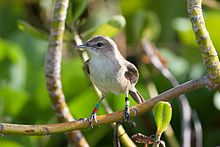- Nihoa Millerbird
-
Nihoa Millerbird 
Conservation status Scientific classification Kingdom: Animalia Phylum: Chordata Class: Aves Order: Passeriformes Family: Acrocephalidae Genus: Acrocephalus Species: A. familiaris Subspecies: A. f. kingi Trinomial name Acrocephalus familiaris kingi
(Wetmore, 1923)The Nihoa Millerbird (Acrocephalus familiaris kingi) is a subspecies of the Millerbird. It gets its name from its preferred food, the Miller moth. The five-inch long Millerbird has dark, sepia-colored feathers, white belly, and dark beak. Its natural geographic range is limited to the tiny island of Nihoa in the Northwestern Hawaiian Islands, and it is hoped that birds translocated to Laysan will help to ensure the survival of the species. The Nihoa Millerbird is one of the two endemic birds remaining on Nihoa, the other being the Nihoa Finch.
Only 200– 900 Nihoa Millerbirds persist on the island, making the species seriously endangered. It is always at risk of extinction from environmental changes (droughts, fires, insect population irruptions), because flight away from the island would likely prove fatal. The Laysan Millerbird, now extinct, was closely related.[1]
The trinomial commemorates Samuel Wilder King, captain of the Tanager Expedition and later Governor of Hawaii.
Conservation
 A millerbird wearing coloured leg bands shortly after translocation from Nihoa to Laysan
A millerbird wearing coloured leg bands shortly after translocation from Nihoa to Laysan
24 Nihoa Millerbirds were translocated by ship about 650 miles from Nihoa to Laysan in September 2011 after years of planning with the aim of establishing a second population of the species on Laysan. The birds were provided with different combinations of coloured leg bands to help identification of individual birds.[1]
References
- ^ "Release of Nihoa Millerbirds on Laysan Island Offers New Hope for Critically Endangered Species". US Fish & Wildlife service. http://us.vocuspr.com/Newsroom/Query.aspx?SiteName=FWS&Entity=PRAsset&SF_PRAsset_PRAssetID_EQ=128401&XSL=PressRelease&Cache=True. Retrieved 20 September 2011.

This article about an Old World warbler is a stub. You can help Wikipedia by expanding it.

